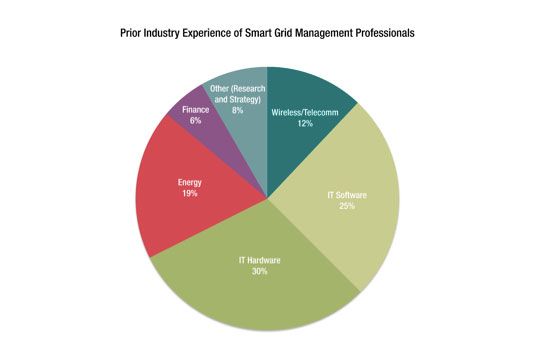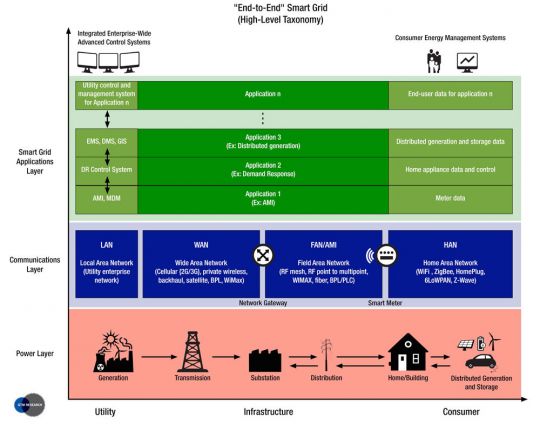The following perspective is based on concepts that are explained in more detail in the free report The Smart Grid in 2010: Market Segments, Applications and Industry Players.
One of the stories to watch in smart grid will continue to be which market segments are getting funded. While smart grid has been receiving its first run of major media attention these past nine months, certain sub-markets, notably advanced metering infrastructure (AMI), are no longer in the early stages and will be tough places for upstarts to enter the market. Meanwhile, others market segments, namely energy-aware home area networking (HAN), may have attracted too much attention of late while their immediate value proposition remains unclear. Finding the market segment that is "just right" – neither too cold nor too hot – will continue to be the preoccupation of a venture capital community increasingly taken by smart grid. In our opinion, don't be surprised to see VCs flock to an emerging market segment that GTM Research is calling "The Soft Grid."
To date – with a few notable exceptions – the most funded smart grid startup companies are those competing in the AMI networking and communications space. Silver Spring Networks, SmartSynch, Trilliant and Eka Systems have collectively raised close to $350 million (with Silver Spring pulling in the lion's share, with more than $165 million). Smart meters and their corresponding networks provide the missing link in communications between the utility and the end user, and have widely been considered the solution that must be deployed first. However, with approximately 41 million meters now scheduled to be deployed in North America over the next five years, and IT giants such as Cisco, as well as the leading wireless service providers (AT&T, Verizon, Sprint, & T-Mobile) now jumping on board, this market can now be seen as maturing, and is not likely to remain in the realm of startups and VC dollars.
Click on the above image to a see a higher-resolution version of this taxonomy.
While the moment to place bets on AMI networking companies may have passed by, what is compelling, as we approach 2010, and this communication layer gets built out, is that a platform will now exist (the blue layer in the above taxonomy taken from The Smart Grid in 2010: Market Segments, Applications and Industry Players) to support countless new applications needed to improve the generation, distribution, consumption, and monitoring of the Grid.
The development of this applications space, we predict, will be the beginning of Smart Grid 2.0 – "The Soft Grid" – and will likely usher in a period increased entrepreneurial interest and VC investment in the software needed to support and enable many of the smart grid sub-markets including: advanced metering, demand response, grid optimization, distributed generation and storage integration, PHEV smart charging, as well as integrated advanced control systems for both utilities and end-users. New and advanced software solutions will continue to be demanded and developed for this industry; everything from advanced communications protocol software to user interface software to application-specific software.
The infrastructure hardware of the smart grid is undoubtedly necessary and important, but it's the intelligent software – "The Soft Grid" – that has the ability to truly revolutionize this market and provide vendors an opportunity to create defendable intellectual property and differentiation.
Beyond the obvious and relevant comparisons to the iPhone (and Apple's huge successes in allowing third-party programmers to develop "apps" on top of its platform), what is particularly interesting about the soft grid is that the business models of these young companies will be both recognizable and digestible to VCs, accustomed to making investments of just a few million dollars on targeted software plays. Relative to building a solar manufacturing plant, attempting to develop bio-diesel from algae, or other capital-intensive greentech projects, the soft grid provides a remarkably "capital efficient" alternative.

What's more – and in all seriousness – is that a shift in the "coolness factor" associated with working either for a utility or a related smart grid/soft grid/renewable energy company is now occurring. Historically, there hasn't been much overlap between the utility world and the IT software world – the center of innovation in the U.S. economy the past two decades – in fact, there's been an almost complete disconnect. The above pie graph shows the beginnings of a transition of management professionals from the IT software, and other technology fields, into the smart grid sector. With all due and intended respect to the men and women of this industry, jobs in the utility sector haven't exactly been the sexy positions that the nation's top engineer and MBA students have been tripping over each other to land.
Fast-forward to 2009, and now you have a situation where utility executives are being jetted across the globe to talk smart grid shop, and to demonstrate how and where IT, telecomm and energy are converging – suddenly, this is an exciting industry to be involved with. A recent trend has grid startup companies plucking utility execs from their posts, revealing a pent-up demand for industry knowledge (and connections) in bringing new applications and services to market.
While the startups may continue to edge the utilities in terms of overall cachet, the key insight is that this industry is now an attractive place to hang one's hat, and as such we anticipate that the electric power sector will be inundated with a wave of fresh talent in the next five years. These individuals will come into smart grid/soft grid looking to tackle very specific challenges, such as regulating the voltage (to avoid flicker or excessive voltage drop) or plugging PV into the grid at scale (in a way that doesn't create back feed issues on the distribution grid) while at the same time in full awareness that in 2010 there exists great potential for personal profit and prestige.
Startups eMeter and Ecological Analytics are two examples of soft grid companies starting to hit their stride. Both companies provide meter data management (MDM) software helping to translate data from smart meters into actionable intelligence for utilities (and both have scored large contracts with major utilities). Notably, eMeter recently secured an additional $32 million in financing, suggesting that the prospects for MDM continue to be very strong. Also of note, GridPoint, another prominent example of a soft grid company, out-raised all other companies in the smart grid (including the networking players). While admittedly there is not necessarily a correlation between the amount of money a company raises and its ability to successfully bring a product or service to market, raising $220 million can't hurt. GridPoint's "shoot the moon" strategy has it looking to deliver software solutions to every promising application of the smart grid. Will the winning solution be an end-to-end software play or a point-solution software play? Time will tell.
Today there is still a relatively small number soft grid pure play companies; however, the amount of opportunity to upgrade an industry that has lagged behind in IT investment (and which, by the way, generates roughly $350 billion in annual revenue, in the U.S. alone) is considerable.
The platform, the infrastructure, is getting built, talent is moving into the space and The Era of The Soft Grid is upon us and will be for several years to come.
Interact with smart grid industry visionaries from North American utilities, innovative hardware and software vendors and leading industry consortiums at The Networked Grid on November 4 in San Francisco.





